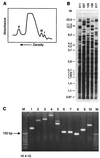Short-sequence DNA repeats in prokaryotic genomes
- PMID: 9618442
- PMCID: PMC98915
- DOI: 10.1128/MMBR.62.2.275-293.1998
Short-sequence DNA repeats in prokaryotic genomes
Abstract
Short-sequence DNA repeat (SSR) loci can be identified in all eukaryotic and many prokaryotic genomes. These loci harbor short or long stretches of repeated nucleotide sequence motifs. DNA sequence motifs in a single locus can be identical and/or heterogeneous. SSRs are encountered in many different branches of the prokaryote kingdom. They are found in genes encoding products as diverse as microbial surface components recognizing adhesive matrix molecules and specific bacterial virulence factors such as lipopolysaccharide-modifying enzymes or adhesins. SSRs enable genetic and consequently phenotypic flexibility. SSRs function at various levels of gene expression regulation. Variations in the number of repeat units per locus or changes in the nature of the individual repeat sequences may result from recombination processes or polymerase inadequacy such as slipped-strand mispairing (SSM), either alone or in combination with DNA repair deficiencies. These rather complex phenomena can occur with relative ease, with SSM approaching a frequency of 10(-4) per bacterial cell division and allowing high-frequency genetic switching. Bacteria use this random strategy to adapt their genetic repertoire in response to selective environmental pressure. SSR-mediated variation has important implications for bacterial pathogenesis and evolutionary fitness. Molecular analysis of changes in SSRs allows epidemiological studies on the spread of pathogenic bacteria. The occurrence, evolution and function of SSRs, and the molecular methods used to analyze them are discussed in the context of responsiveness to environmental factors, bacterial pathogenicity, epidemiology, and the availability of full-genome sequences for increasing numbers of microorganisms, especially those that are medically relevant.
Figures






References
-
- Aaltonen L A, Peltomaki P, Leach F S, Sistonen P, Pylkkanen L, Mecklin J, Jarvinen H, Powell S M, Jen J, Hamilton S R, Petersen G M, Kinzler K W, Vogelstein B, de la Chapelle A. Clues to the pathogenesis of familial colorectal cancer. Science. 1993;260:812–816. - PubMed
-
- Arbeit R D. Laboratory procedures for the epidemiologic analysis of staphylococci. In: Archer G L, Grassley K B, editors. The biology of staphylococci. New York, N.Y: Churchill Livingstone; 1996. pp. 253–286.
-
- Asayama M, Kabasawa M, Takahashi I, Aida T, Shirai M. Highly repetitive sequences and characteristics of genomic DNA in unicellular cyanobacterial strains. FEMS Microbiol Lett. 1996;137:175–181. - PubMed
Publication types
MeSH terms
Substances
LinkOut - more resources
Full Text Sources
Other Literature Sources

